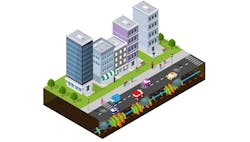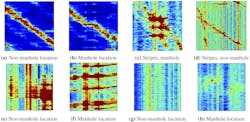Existing underground fiber-optic telecommunications cable networks that can be accessed through street manholes are helping a team at NEC Labs America (Princeton, NJ) improve wireless communications systems and the Internet of Things (IoT).
“Hundreds of millions of fiber-optic cables are already there for communications purposes,” says Shaobo Han, a researcher at NEC Labs America who focuses on the design and development of machine learning and signal-processing techniques for real-world sensing applications. “We’re turning it all into a ‘thinking’ device, using the same cable that’s already there.”
Using the existing cable networks, Han’s team can monitor and track the path of almost any object above ground without installing additional sensors or connecting to wireless networks (see video and Fig. 1). The fiber sensing system provides optical as well as acoustic information by using thin-film optoelectronics as an integrator that sends out optical power from lasers to the optical fiber. By analyzing its scattering, information about physical parameters such as acoustical aberration and temperatures can be found.
Landmarks
Fiber optics allow researchers to sense two primary categories: moving and non-moving objects.
Things that don’t move like cables and manholes serve as landmarks. Potholes or pavement deformations on the road surface are also static markers the underground fiber sensing system can detect. Moving objects include vehicle traffic or construction equipment in use.
Like a lighthouse serving as a reference point to navigate the location of ships on the ocean, manholes can help determine the location of detected acoustic events.
“When we use fiber sensing to detect events, we know how far it is from the sensor, how many meters away,” Han says. “We don’t necessarily know GPS locations because the cable is not directly in a straight line. It may come across different blocks of the street. It’s necessary to establish mapping between the physical world and the digital world.”
Geolocalization, Han notes, is a prerequisite for sensing. Previously, a person needed to physically visit each manhole, “maybe even blocking the street traffic and then knocking out the manhole power basically to create something recognizable.” This manual field surveying is very labor-intensive and time-consuming.
The team’s fiber sensing approach presents alternatives. Among them: using ambient traffic noise on the road surface because the data obtained aids automatic manhole localization (see Fig. 2).“We learn from ambient noise,” Han says. “Normally when we connect the sensor to a cable, we immediately sense the traffic on the road. With these static objects such as manholes and this fiber sensing technology, we collect the data over time and analyze the how the infrastructure and vehicles interact.”
The way a car interacts with a road surface is different than with a manhole, and it makes the manhole recognizable via fiber sensing data.
Implementing AI, machine learning
The researchers built a machine-learning model to detect acoustic events above ground and identify the paths and differences in ambient noises produced by various objects in real time. It essentially replaces the need for manual efforts.
The system can also pinpoint defects and other issues with the cables used by wireless communications providers quickly and more accurately than conventional methods, and at a fraction of the typical maintenance costs.
“AI and machine learning are used a lot in distributed fiber-optical sensing,” Han says, citing an approach currently used to create an event, record the data, and timestamp it.
The team did a trial in which they fired a gun as well as set off a firework. “We could do a weakly supervised machine-learning model to train a neural network to distinguish a gunshot from a firework. It’s called weakly supervised learning because the interesting event is already there, it already happened through the data,” says Han. “The neural network just needs to learn how to do the classification. AI computes these physical parameters into high-level, meaningful events, such as a car driving by, an earthquake, a machine working and digging in the ground, or flooding.”
Their fiber-optic-based system may also help advance smart cities and IoT, and aid communications service providers that use underground fiber optics. It could help city planners better understand and improve things like traffic patterns, while also providing law enforcement with more detailed information to investigate traffic accidents.
“This system could make a city safer,” Han says.

Justine Murphy | Multimedia Director, Digital Infrastructure
Justine Murphy is the multimedia director for Endeavor Business Media's Digital Infrastructure Group. She is a multiple award-winning writer and editor with more 20 years of experience in newspaper publishing as well as public relations, marketing, and communications. For nearly 10 years, she has covered all facets of the optics and photonics industry as an editor, writer, web news anchor, and podcast host for an internationally reaching magazine publishing company. Her work has earned accolades from the New England Press Association as well as the SIIA/Jesse H. Neal Awards. She received a B.A. from the Massachusetts College of Liberal Arts.

